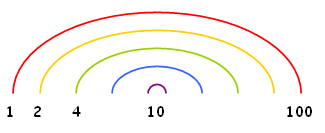|  Hide Notes Hide Notes
Overview:  Factors are fascinating. Why do some numbers have lots of factors, whereas others have very few? Is there a connection betwen them? These investigations encourage open-ended exploration. Factors are fascinating. Why do some numbers have lots of factors, whereas others have very few? Is there a connection betwen them? These investigations encourage open-ended exploration.
Knowing the factors of 100 will help with fraction decimal equivalence. Knowing the factors of 12, 24, 60 and 360 will help with time and angles.
The photocopiable investigation Multiplication Rectangles and Factor Rainbows goes into this in much more depth.
| | | | |
Step 4 | | Notes for Teachers:
Discuss where you would cut a metre stick to chop it into two equal pieces (p3). Make the link with halves (p4) and factor pairs (p5).
Next work out where to cut if you want to chop a metre stick into four equal pieces (p8). Again, make the link with quarters (p7) and factor pairs (p8). Repeat for five equal pieces (p9) and then ten (p12).
Finally, draw the factor rainbow for 100 (p15) and then build the factor pair pattern (p16). | | Quiz: Factor pairs that make 100. (eg 4 x 25 = 100) |
|  Hide Notes Hide Notes  See champions and stars See champions and stars
| |
|
Step 5 | | Notes for Teachers:
Discuss the fact that the numbers 12, 24 and 60 are used a lot when measuring time (p1).
Investigate the factors of 12 (p3), draw the factor rainbow (p5) and build the factor pair pattern (p6). Explore the link with months (p7).
Repeat for 24 (p8), exploring the link with hours (p12). Then repeat with 60 (p13), exploring the link with minutes (p17). | | Quiz: Knowledge of the factor pairs for 12, 24 and 60. (eg 4 x 15 = 60) |
|  Hide Notes Hide Notes  See champions and stars See champions and stars
| |
|
Step 6 | | Notes for Teachers:
Discuss the fact that for thousands of years people have measured angles in a circle by dividing the circle into 360 equal degrees (p1). Speculate as to why the number 360 might have been chosen (365 days in a year, but 365 does not divide up nicely - 360 is close to 365 and does divide up nicely).
Explore the idea that if there are 360 degrees in a full revolution, there will be 180 degress in half a revolution (p2) and 90 in a right angle (p4).
Consider a compass rose with 8 points, work out the angle between the points (p6) and investigate the link with factor pairs (p7).
Next consider hours on a clock (p8), angles in the six equilateral triangles in a hexagon (p10), a three armed windmill (p12) and then minutes on a clock (p14), investigating the angles each time and relating them to factor pairs.
See how many other factors you can find for 360 (p16) and then build the factor pairs pattern (p17). Finally draw the factor rainbow (p19). | | Quiz: Knowledge of all the factor pairs for 360. (eg 30x12=360) |
|  Hide Notes Hide Notes  See champions and stars See champions and stars
| |
| | |
|
|

